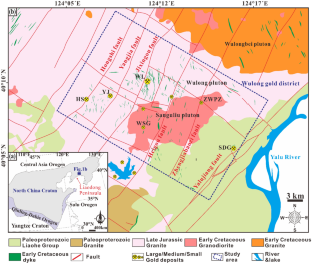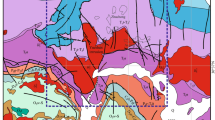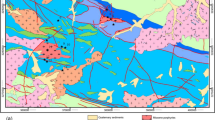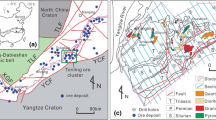Abstract
The uncertainty inherent in three-dimensional (3D) mineral prospectivity mapping (MPM) encompasses (a) mineral system conceptual model uncertainty stemming from geological conceptual frameworks, (b) aleatoric uncertainty, attributable to the variability and noise due to multi-source geoscience datasets collection and processing, as well as 3D geological modeling process, and (c) epistemic uncertainty due to predictive algorithm modeling. Quantifying the uncertainty of 3D MPM is a prerequisite for accepting predictive models in exploration. Previous MPM studies were centered on addressing the mineral system conceptual model uncertainty. To the best of our knowledge, few studies quantified the aleatoric and epistemic uncertainties of 3D MPM. This study proposes a novel uncertainty-quantification machine learning framework to qualify aleatoric and epistemic uncertainties in 3D MPM by the uncertainty-quantification random forest. Another innovation of this framework is utility of the accuracy–rejection curve to provide a quantitative uncertainty threshold for exploration target delineation. The Bayesian hyperparameter optimization tunes the hyperparameters of the uncertainty-quantification random forest automatically. The case study of 3D MPM for exploration target delineation in the Wulong gold district of China demonstrated the practicality of our framework. The aleatoric uncertainty of the 3D MPM indicates that the 3D Early Cretaceous dyke model is the main source of this uncertainty. The 3D exploration targets delineated by the uncertainty-quantification machine learning framework can benefit subsurface gold exploration in the study area.














Similar content being viewed by others
References
Agterberg, F. P. (1989). Computer programs for mineral exploration. Science, 245, 7681.
Anderson, E. D., Monecke, T., Hitzman, M. W., Zhou, W., & Bedrossian, P. A. (2017). Mineral potential mapping in an accreted island-arc setting using aeromagnetic data: An example from Southwest Alaska. Economic Geology, 112, 375–396.
Bergstra, J., Yamins, D. & Cox, D. D. (2013). Hyperopt: a python library for optimizing the hyperparameters of machine learning algorithms. In Proceedings of the 12th Python in science conference, 13, 20. Citeseer.
Breiman, L. (2001). Random forests. Machine Learning, 45, 5s32.
Burkin, J. N., Lindsay, M. D., Occhipinti, S. A., & Holden, E. J. (2019). Incorporating conceptual and interpretation uncertainty to mineral prospectivity modelling. Geoscience Frontiers, 10(4), 1383–1396.
Carranza, E. J. M. (2008). Geochemical Anomaly and Mineral Prospectivity Mapping in GIS (p. 11). New York: Elsevier.
Carranza, E. J. M., & Hale, M. (2001). Geologically constrained fuzzy mapping of gold mineralization potential, Baguio district, Philippines. Natural Resources Research, 10, 125–136.
Carranza, E. J. M., & Laborte, A. G. (2015). Data-driven predictive mapping of gold prospectivity, Baguio district, Philippines: Application of Random Forests algorithm. Ore Geology Reviews, 71, 777–787.
Deng, H., Zheng, Y., Chen, J., Yu, S., Xiao, K., & Mao, X. (2022). Learning 3D mineral prospectivity from 3D geological models using convolutional neural networks: Application to a structure-controlled hydrothermal gold deposit. Computers & Geosciences, 161, 105074.
Du, B., Wang, Z., Santosh, M., Shen, Y., Liu, S., Liu, J., Xu, K., & Deng, J. (2023). Role of metasomatized mantle lithosphere in the formation of giant lode gold deposits: Insights from sulfur isotope and geochemistry of sulfides. Geoscience Frontiers, 14(5), 101587.
Feng, H., Shen, P., Zhu, R., Tomkins, A. G., Brugger, J., Ma, G., Li, C., & Wu, Y. (2023). Bi/Te control on gold mineralizing processes in the North China Craton: Insights from the Wulong gold deposit. Mineralium Deposita, 58(2), 263–286.
Gao, M., Wang, G., Carranza, E. J. M., Qi, S., Zhang, W., Pang, Z., Li, X., & Xiao, F. (2024). 3D Au targeting using machine learning with different sample combination and return-risk analysis in the Sanshandao-Cangshang District, Shandong Province, China. Natural Resources Research, 33, 51–74.
Ghorbani, Y., Nwaila, G. T., Zhang, S. E., Bourdeau, J. E., Cánovas, M., Arzua, J., & Nikadat, N. (2023). Moving towards deep underground mineral resources: Drivers, challenges and potential solutions. Resources Policy, 80, 103222.
Harris, J. R., Grunsky, E. C., Behnia, P., & Corrigan, D. (2015). Data-and knowledge-driven mineral prospectivity maps for Canada’s North. Ore Geology Reviews, 71, 788–803.
Huang, D., Zuo, R., & Wang, J. (2022). Geochemical anomaly identification and uncertainty quantification using a Bayesian convolutional neural network model. Applied Geochemistry, 146, 105450.
Hüllermeier, E., & Waegeman, W. (2021). Aleatoric and epistemic uncertainty in machine learning: An introduction to concepts and methods. Machine Learning, 110, 457–506.
Jordão, H., Sousa, A. J., & Soares, A. (2023). Using Bayesian neural networks for uncertainty assessment of ore type boundaries in complex geological models. Natural Resources Research, 32, 2495–2514.
Kendall, A., & Gal, Y. (2017). What uncertainties do we need in Bayesian deep learning for computer vision? In Advances in neural information processing systems (Vol. 30).
Kreuzer, O. P., Etheridge, M. A., Guj, P., McMahon, M. E., & Holden, D. J. (2008). Linking mineral deposit models to quantitative risk analysis and decision-making in exploration. Economic Geology, 103, 829–850.
Li, R., Wang, G., & Carranza, E. J. M. (2016). GeoCube: A 3D mineral resources quantitative prediction and assessment system. Computers & Geosciences, 89, 161–173.
Li, X., Xue, C., Chen, Y., Yuan, F., Li, Y., Zheng, C., Zhang, M., Ge, C., Guo, D., Lan, X., Tang, M., & Lu, S. (2023). 3D Convolutional Neural Network-based 3D mineral prospectivity modeling for targeting concealed mineralization within Chating area, middle-lower Yangtze River metallogenic Belt, China. Ore Geology Reviews, 157, 105444.
Li, Y., & Oldenburg, D. W. (1996). 3-D inversion of magnetic data. Geophysics, 61(2), 394–408.
Li, Y., & Oldenburg, D. W. (1998). 3-D inversion of gravity data. Geophysics, 63(1), 109–119.
Lindsay, M. D., Piechocka, A. M., Jessell, M. W., Scalzo, R., Giraud, J., Pirot, G., & Cripps, E. (2022). Assessing the impact of conceptual mineral systems uncertainty on prospectivity predictions. Geoscience Frontiers, 13(6), 101435.
Lisitsin, V. A., Porwal, A., & McCuaig, T. C. (2014). Probabilistic fuzzy logic modeling: quantifying uncertainty of mineral prospectivity models using Monte Carlo simulations. Mathematical Geosciences, 46, 747–769.
Liu, J., Zhang, L., Wang, S., Li, T., Yang, Y., Liu, F., Li, S., & Duan, C. (2019). Formation of the Wulong gold deposit, Liaodong gold Province, NE China: Constraints from zircon U–Pb age, sericite Ar–Ar age, and H–O–S–He isotopes. Ore Geology Reviews, 109, 130–143.
Lü, Q., Qi, G., & Yan, J. (2013). 3D geologic model of Shizishan ore field constrained by gravity and magnetic interactive modeling: A case history. Geophysics, 78(1), B25–B35.
Malehmir, A., Thunehed, H., & Tryggvason, A. (2009). The Paleoproterozoic Kristineberg mining area, northern Sweden: Results from integrated 3D geophysical and geologic modeling, and implications for targeting ore deposits. Geophysics, 74(1), B9–B22.
Manzi, M., Cooper, G., Malehmir, A., Durrheim, R., & Nkosi, Z. (2015). Integrated interpretation of 3D seismic data to enhance the detection of the gold-bearing reef: Mponeng Gold mine, Witwatersrand Basin (South Africa). Geophysical Prospecting, 63(4-Hard Rock Seismic imaging), 881–902.
Mao, X., Liu, P., Deng, H., Liu, Z., Li, L., Wang, Y., Ai, Q., & Liu, J. (2023a). A novel approach to three-dimensional inference and modeling of magma conduits with exploration data: A case study from the Jinchuan Ni–Cu sulfide deposit, NW China. Natural Resources Research, 32, 901–928.
Mao, X., Wang, J., Deng, H., Liu, Z., Chen, J., Wang, C., & Liu, J. (2023b). Bayesian decomposition modelling: An interpretable nonlinear approach for mineral prospectivity mapping. Mathematical Geosciences, 55, 897–942.
McCuaig, T. C., Beresford, S., & Hronsky, J. (2010). Translating the mineral systems approach into an effective exploration targeting system. Ore Geology Reviews, 38(3), 128–138.
Nielsen, S. H. H., Partington, G. A., Franey, D., & Dwight, T. (2019). 3D mineral potential modelling of gold distribution at the Tampia gold deposit. Ore Geology Reviews, 109, 276–289.
Payne, C. E., Cunningham, F., Peters, K. J., Nielsen, S., Puccioni, E., Wildman, C., & Partington, G. A. (2015). From 2D to 3D: Prospectivity modelling in the Taupo volcanic zone, New Zealand. Ore Geology Reviews, 71, 558–577.
Porwal, A., Carranza, E. J. M., & Hale, M. (2006). A hybrid fuzzy weights-of-evidence model for mineral potential mapping. Natural Resources Research, 15, 1–14.
Porwal, A., Gonzalez-Alvarez, I., Markwitz, V., McCuaig, T. C., & Mamuse, A. (2010). Weights-of-evidence and logistic regression modeling of magmatic nickel sulfide prospectivity in the Yilgarn Craton, Western Australia. Ore Geology Reviews, 38(3), 184–196.
Senge, R., Bösner, S., Dembczyński, K., Haasenritter, J., Hirsch, O., Donner-Banzhoff, N., & Hüllermeier, E. (2014). Reliable classification: Learning classifiers that distinguish aleatoric and epistemic uncertainty. Information Sciences, 255, 16–29.
Shaker, M. H., & Hüllermeier, E. (2020). Aleatoric and epistemic uncertainty with random forests. In Advances in intelligent data analysis XVIII: 18th international symposium on intelligent data analysis, IDA 2020, Konstanz, Germany, April 27–29, 2020, proceedings 18 (pp. 444-456). Springer.
Smith, L. N. (2018). A disciplined approach to neural network hyper-parameters: Part 1—learning rate, batch size, momentum, and weight decay. arXiv preprint arXiv:1803.09820.
Wang, G., Li, R., Carranza, E. J. M., Zhang, S., Yan, C., Zhu, Y., Qu, J., Hong, D., Song, Y., Han, J., Ma, Z., Zhang, H., & Yang, F. (2015). 3D geological modeling for prediction of subsurface Mo targets in the Luanchuan district, China. Ore Geology Reviews, 71, 592–610.
Wang, J., & Zuo, R. (2023). A Monte Carlo-based workflow for geochemical anomaly identification under uncertainty and global sensitivity analysis of model parameters. Mathematical Geosciences, 55(8), 1075–1099.
Wang, Z., Yin, Z., Caers, J., & Zuo, R. (2020). A Monte Carlo-based framework for risk-return analysis in mineral prospectivity mapping. Geoscience Frontiers, 11(6), 2297–2308.
Wei, J., Liu, C., & Tang, H. (2003). Rb-Sr and U-Pb isotopic systematics of pyrite and granite in Liaodong gold province, North China: Implication for the age and genesis of a gold deposit. Geochemical Journal, 37(5), 567–577.
Wu, F., Yang, J., Wilde, S. A., & Zhang, X. (2005). Geochronology, petrogenesis and tectonic implications of Jurassic granites in the Liaodong Peninsula. NE China. Chemical geology, 221(1–2), 127–156.
Wyborn, L. A. I., Heinrich, C. A. $ Jaques, A. L. (1994). Australian Proterozoic mineral systems: essential ingredients and mappable criteria. In Australian Institute of Mining and Metallurgy annual conference, Melbourne, proceedings (pp. 109–115).
Xiang, J., Xiao, K., Carranza, E. J. M., Chen, J., & Li, S. (2020). 3D mineral prospectivity mapping with random forests: A case study of Tongling, Anhui, China. Natural Resources Research, 29, 395–414.
Xiong, Y., & Zuo, R. (2018). GIS-based rare events logistic regression for mineral prospectivity mapping. Computers & Geosciences, 111, 18–25.
Yang, F., Wang, Z., Zuo, R., Sun, S., & Zhou, B. (2023). Quantification of uncertainty associated with evidence layers in mineral prospectivity mapping using direct sampling and convolutional neural network. Natural Resources Research, 32, 79–98.
Yong, B. X., & Brintrup, A. (2022). Bayesian autoencoders with uncertainty quantification: Towards trustworthy anomaly detection. Expert Systems with Applications, 209, 118196.
Yousefi, M., & Carranza, E. J. M. (2015). Prediction–area (P–A) plot and C–A fractal analysis to classify and evaluate evidential maps for mineral prospectivity modeling. Computers & Geosciences, 79, 69–81.
Yousefi, M., Lindsay, M. D., & Kreuzer, O. (2024). Mitigating uncertainties in mineral exploration targeting: Majority voting and confidence index approaches in the context of an exploration information system (EIS). Ore Geology Reviews, 165, 105930.
Yu, B., Zeng, Q., Frimmel, H. E., Qiu, H., Li, Q., Yang, J., Wang, Y., Zhou, L., Chen, P., & Li, J. (2020). The 127 Ma gold mineralization in the Wulong deposit, Liaodong Peninsula, China: constraints from molybdenite Re-Os, monazite U-Th-Pb, and zircon U-Pb geochronology. Ore Geology Reviews, 121, 103542.
Yu, B., Zeng, Q., Frimmel, H. E., Wang, Y., Guo, W., Sun, G., Zhou, T., & Li, J. (2018). Genesis of the Wulong gold deposit, northeastern North China Craton: Constraints from fluid inclusions, HOS-Pb isotopes, and pyrite trace element concentrations. Ore Geology Reviews, 102, 313–337.
Yuan, F., Li, X., Zhang, M., Jowitt, S. M., Jia, C., Zheng, T., & Zhou, T. (2014). Three-dimensional weights of evidence-based prospectivity modeling: A case study of the Baixiangshan mining area, Ningwu Basin, Middle and Lower Yangtze Metallogenic Belt, China. Journal of Geochemical Exploration, 145, 82–97.
Zhang, H., Quost, B., & Masson, M. H. (2023a). Cautious weighted random forests. Expert Systems with Applications, 213, 118883.
Zhang, P., Kou, L., Zhao, Y., Bi, Z., Sha, D., Han, R., & Li, Z. (2020a). Genesis of the Wulong gold deposit, Liaoning Province, NE China: Constrains from noble gases, radiogenic and stable isotope studies. Geoscience Frontiers, 11(2), 547–563.
Zhang, S., Zhu, G., Xiao, S., Su, N., Liu, C., Wu, X., Yin, H., & Lu, Y. (2020b). Temporal variations in the dynamic evolution of an overriding plate: Evidence from the Wulong area in the eastern North China Craton. China. GSA Bulletin, 132(9–10), 2023–2042.
Zhang, W., Wu, C., Zhong, H., Li, Y., & Wang, L. (2021a). Prediction of undrained shear strength using extreme gradient boosting and random forest based on Bayesian optimization. Geoscience Frontiers, 12(1), 469–477.
Zhang, Z., Wang, G., Carranza, E. J. M., Fan, J., Liu, X., Zhang, X., Dong, Y., Chang, X., & Sha, D. (2022). An integrated framework for data-driven mineral prospectivity mapping using bagging-based positive-unlabeled learning and Bayesian cost-sensitive logistic regression. Natural Resources Research, 31, 3041–3060.
Zhang, Z., Wang, G., Carranza, E. J. M., Liu, C., Li, J., Fu, C., Fan, J., & Dong, Y. (2023b). An integrated machine learning framework with uncertainty quantification for three-dimensional lithological modeling from multi-source geophysical data and drilling data. Engineering Geology, 324, 107255.
Zhang, Z., Wang, G., Carranza, E. J. M., Zhang, J., Tao, G., Zeng, Q., Sha, D., Li, D., Shen, J., & Pang, Z. (2019). Metallogenic model of the Wulong gold district, China, and associated assessment of exploration criteria based on multi-scale geoscience datasets. Ore Geology Reviews, 114, 103138.
Zhang, Z., Wang, G., Liu, C., Cheng, L., & Sha, D. (2021b). Bagging-based positive-unlabeled learning algorithm with Bayesian hyperparameter optimization for three-dimensional mineral potential mapping. Computers & Geosciences, 154, 104817.
Zheng, F., Xu, T., Ai, Y., Yang, Y., Zeng, Q., Yu, B., Zhang, W., & Xie, T. (2022). Metallogenic potential of the Wulong goldfield, Liaodong Peninsula, China revealed by high-resolution ambient noise tomography. Ore Geology Reviews, 142, 104704.
Zhou, X., Wen, H., Zhang, Y., Xu, J., & Zhang, W. (2021). Landslide susceptibility mapping using hybrid random forest with GeoDetector and RFE for factor optimization. Geoscience Frontiers, 12(5), 101211.
Zuo, R., Kreuzer, O. P., Wang, J., Xiong, Y., Zhang, Z., & Wang, Z. (2021). Uncertainties in GIS-based mineral prospectivity mapping: Key types, potential impacts and possible solutions. Natural Resources Research, 30, 3059–3079.
Zuo, R., Xiong, Y., Wang, Z., Wang, J., & Kreuzer, O. P. (2023). A new generation of artificial intelligence algorithms for mineral prospectivity Mapping. Natural Resources Research. https://doi.org/10.1007/s11053-023-10237-w
Zuo, R., Zhang, Z., Zhang, D., Carranza, E. J. M., & Wang, H. (2015). Evaluation of uncertainty in mineral prospectivity mapping due to missing evidence: a case study with skarn-type Fe deposits in Southwestern Fujian Province, China. Ore Geology Reviews, 71, 502–515.
Acknowledgments
This research is supported by Hebei Natural Science Foundation (No. D2023403051), Open Project Program of Hebei Province Collaborative Innovation Center for Strategic Critical Mineral Research, Hebei GEO University, China (No. HGUXT-2023-13), and the MNR Key Laboratory for Exploration Theory & Technology of Critical Mineral Resources (No. 202405).
Author information
Authors and Affiliations
Corresponding author
Ethics declarations
Competing Interests
Authors disclose non-financial interests are directly or indirectly related to this work submitted for publication.
Rights and permissions
Springer Nature or its licensor (e.g. a society or other partner) holds exclusive rights to this article under a publishing agreement with the author(s) or other rightsholder(s); author self-archiving of the accepted manuscript version of this article is solely governed by the terms of such publishing agreement and applicable law.
About this article
Cite this article
Zhang, Z., Wang, G., Carranza, E.J.M. et al. An Uncertainty-Quantification Machine Learning Framework for Data-Driven Three-Dimensional Mineral Prospectivity Mapping. Nat Resour Res (2024). https://doi.org/10.1007/s11053-024-10349-x
Received:
Accepted:
Published:
DOI: https://doi.org/10.1007/s11053-024-10349-x




